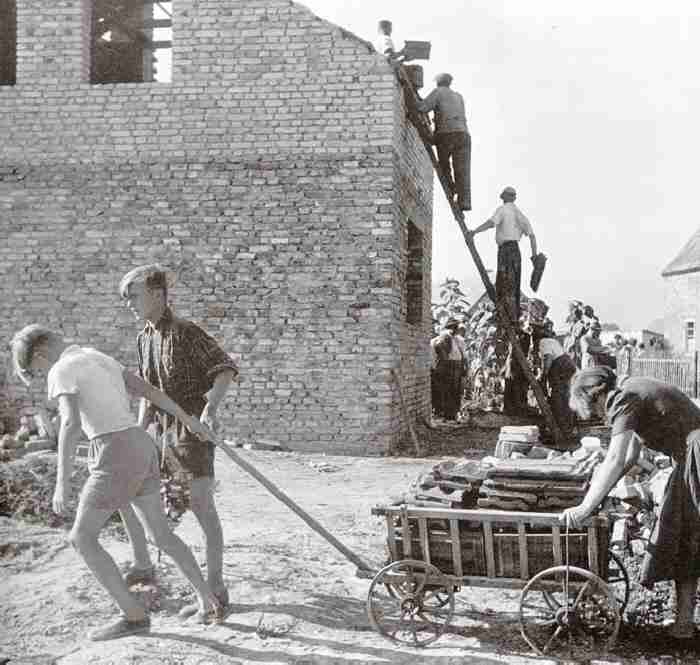
War and Social Upheaval: World War II European Air Campaign--German Historical Reflection

Figure 1.--German cities after the War were left in ruin. Children played in the rubble for years as well assisted in the reconstruction. This photograph was taken at Munich. I'm not sure precisely when it was taken, but would guess about 1946-47. Here the residents of a bombed out community are turning the rubble back into a useful building material. You can see here a house being restored with reclaimed bricks.
|
Surprisingly given the fact that the Germans suffered more than any people in the War from the aerial campaign there has been an almost defening silence from German writers. We note very few writers or film makers who have addressed the subject. One German writer has addressed the question as why the Germans, unlike the British, have not addressed the air war. Given the enormity of the suffering of the German people and the number affected and who witnessed the Allied bombing or the many children who were evcuated in the Kinderlandverschickung (KLV), the silence is indeed notable. One German writer, W.G. Sebald, has broken this silence and not only written about the War and air campaign, but addressed the question as to why the Gemans have been so silent. Sebald suggests that the Germans were shamed by the barbarity of the NAZIs and the totality of Germany's World War II. Of course the best documented is the Holocaust, but there were many other apauling actions by the German Goverment and armed forces. The German plans for the Occupied East almost rival the Holocaust. The ruthless plans to Germanize areas taken by the Wehrmacht are apauling. Not well publicized was the Lebensborn program to kidnap children in the occupied countries. The program of slave and forced labor also resulted in deaths and suffering of subject people. German treatment of Prisioners of War (POWs) was also apauling, especially Polish and Soviet POWs. One of Sebald's characters says, "How I wished that I belonged to another nation." The totality of these crimes sank through to the average German after the War. Some had knew or suspected during the War. For all but hard core NAZIs, the crimes could not be denied after the War. The approach of most Germans was to avoid taking about the War, including how they had suffered. It was almost as if the Germans because of the enormity of their crimes committed in thir name were reluctnt to insist that "We suffered too!. (Here the Japanese have shown no similar reluctance.) For the Germans this included when the children began asking, "Daddy, what did you do in the War?" This reluctance showed up in many small ways. For years after the War, Deutchland was rarely used, rather Germany was referred to as the Bundesrepublik. Even nonmilitary accounts have not appeared. Contrast the abundant British literature and films on the vacuaion of children to the almost complete lack of examination of the German KLV evacutons of children. Seabald gave a series of notable lectures, but in Zurich, not Germany. Only at the turn of the 21st century have German attitudes began to change. One important work is Jörg Friedrich's Der Brand (The Fire) is factual account of the fire bombing of German cities. One reviewer sees it as a rather "self-pittying" account. Several other German authors are now writing books about the British and American air raids on German cities. I recently read an article in the German magazine "Der Spiegel"on this subject. Germany's most famous present-day writer and Nobel prize laureate, Guenter Grass, just
finished a novel about what he refers to as the "Vergeltungsangriffe" (revenge attacks) on the German civilian population. I forgot the title, but I am interested to read it. Now more and more books are being written about their fate and experiences as expellees from other European countries and as bombed-out, homeless people in Germany itself.
Sources
Friederich, Jörg. Der Brand
Sebald, W.G. Trans by Anthea Bell. On the Natural History of Destruction (Random House), 202p.
HBC

Navigate the Boys' Historical Clothing Web Site:
[Return to Main World War II European air campaign reflections page]
[Return to Main World War II European air campaign page]
[Return to Main World War II page]
[Introduction]
[Activities]
[Biographies]
[Chronology]
[Clothing styles]
[Countries]
[Bibliographies]
[Contributions]
[FAQs]
[Glossaries]
[Satellite sites]
[Tools]
[Boys' Clothing Home]
Created: 1:21 AM 8/14/2004
Last updated: 1:21 AM 8/14/2004



